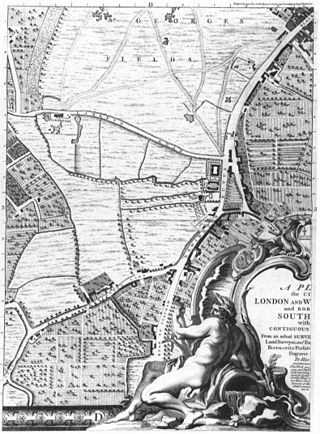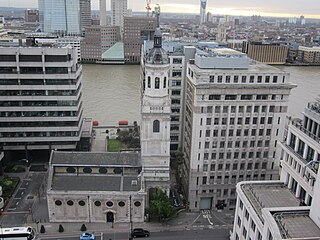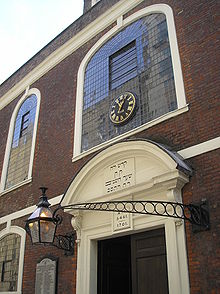The history of London, the capital city of England and the United Kingdom, extends over 2000 years. In that time, it has become one of the world's most significant financial and cultural capital cities. It has withstood plague, devastating fire, civil war, aerial bombardment, terrorist attacks, and riots.

Westminster is the main settlement of the City of Westminster in London, England. It extends from the River Thames to Oxford Street and has many famous landmarks, including the Palace of Westminster, Buckingham Palace, Westminster Abbey, Westminster Cathedral, Trafalgar Square and much of the West End cultural centre including the entertainment precinct of West End Theatre.

Southwark is a district of Central London situated on the south bank of the River Thames, forming the north-western part of the wider modern London Borough of Southwark. The district, which is the oldest part of South London, developed due to its position at the southern end of the early versions of London Bridge, for centuries the only dry crossing on the river. Around 43 AD, engineers of the Roman Empire found the geographic features of the south bank here suitable for the placement and construction of the first bridge.

The London Borough of Southwark in South London forms part of Inner London and is connected by bridges across the River Thames to the City of London and London Borough of Tower Hamlets. It was created in 1965 when three smaller council areas amalgamated under the London Government Act 1963. All districts of the area are within the London postal district. It is governed by Southwark London Borough Council.

Lambeth is a district in South London, England, in the London Borough of Lambeth. Lambeth was an ancient parish in the county of Surrey. It is situated 1 mile (1.6 km) south of Charing Cross, across the river from Westminster Palace. The population of the London Borough of Lambeth was 303,086 in 2011. The area experienced some slight growth in the medieval period as part of the manor of Lambeth Palace. By the Victorian era the area had seen significant development as London expanded, with dense industrial, commercial and residential buildings located adjacent to one another. The changes brought by World War II altered much of the fabric of Lambeth. Subsequent development in the late 20th and early 21st centuries has seen an increase in the number of high-rise buildings. The area is home to the International Maritime Organization. Lambeth is home to one of the largest Portuguese-speaking communities in the UK, and Portuguese is the second most commonly spoken language in Lambeth after English.

St Thomas' Hospital is a large NHS teaching hospital in Central London, England. It is one of the institutions that compose the King's Health Partners, an academic health science centre. Administratively part of the Guy's and St Thomas' NHS Foundation Trust, together with Guy's Hospital, King's College Hospital, University Hospital Lewisham, and Queen Elizabeth Hospital, it provides the location of the King's College London GKT School of Medical Education.

St George's Fields was an area of Southwark in south London, England.

St Magnus the Martyr, London Bridge, is a Church of England church and parish within the City of London. The church, which is located in Lower Thames Street near The Monument to the Great Fire of London, is part of the Diocese of London and under the pastoral care of the Bishop of Fulham. It is a Grade I listed building. The rector uses the title "Cardinal Rector" and, since the abolition of the College of Minor Canons of St Paul's Cathedral in 2016, is the only cleric in the Church of England to use the title cardinal.

London's architectural heritage involves many architectural styles from different historical periods. London's architectural eclecticism stems from its long history, continual redevelopment, destruction by the Great Fire of London and The Blitz, and state recognition of private property rights which have limited large-scale state planning. This sets London apart from other European capitals such as Paris and Rome which are more architecturally homogeneous. London's architecture ranges from the Romanesque central keep of The Tower of London, the great Gothic church of Westminster Abbey, the Palladian royal residence Queen's House, Christopher Wren's Baroque masterpiece St Paul's Cathedral, the High Victorian Gothic of The Palace of Westminster, the industrial Art Deco of Battersea Power Station, the post-war Modernism of The Barbican Estate and the Postmodern skyscraper 30 St Mary Axe 'The Gherkin'.

This article covers the history of London from the Norman conquest of England in 1066 to the death of Richard III in 1485. During this period, London became the capital of England, as monarchs held Parliament at the Palace of Westminster, beginning in 1265 and increasing over the 14th century. London appointed its first recorded Lord Mayor in this period, Henry FitzAilwin, in 1189. In the 12th century, the writer William Fitzstephen described it as florilegium urbanum — "flower of cities".

The Tudor period in London started with the beginning of the reign of Henry VII in 1485 and ended in 1603 with the death of Elizabeth I. During this period, the population of the city grew enormously, from about 50,000 at the end of the 15th century to an estimated 200,000 by 1603, over 13 times that of the next-largest city in England, Norwich. The city also expanded to take up more physical space, further exceeding the bounds of its old medieval walls to reach as far west as St. Giles by the end of the period. In 1598, the historian John Stow called it "the fairest, largest, richest and best inhabited city in the world".

The Stuart period in London began with the reign of James VI and I in 1603 and ended with the death of Queen Anne in 1714. London grew massively in population during this period, from about 200,000 in 1600 to over 575,000 by 1700, and in physical size, sprawling outside its city walls to encompass previously outlying districts such as Shoreditch, Clerkenwell, and Westminster. The city suffered several large periods of devastation, including the English Civil War and the Great Fire of London, but new areas were built from scratch in what had previously been countryside, such as Covent Garden, Bloomsbury, and St. James's, and the City was rebuilt after the Fire by architects such as Christopher Wren.

St Laurence Pountney was a Church of England parish church in the Candlewick ward of the City of London. It was destroyed in the Great Fire of 1666, and not rebuilt.
Long View of London from Bankside is a panoramic etching made by Wenceslas Hollar in Antwerp in 1647. It depicts a panorama of London, based on drawings done while Hollar was in London in the early 1640s. Unlike earlier panoramas of London, Hollar's panorama takes a single viewpoint, the tower of St Saviour in Southwark, from where he made the drawings. It shows the River Thames curving sinuously from left to right past the viewpoint.
The following outline is provided as an overview of and topical guide to the city known as London:

The following is a timeline of the history of Reading, the county town of Berkshire in England.

West London is the western part of London, England, north of the River Thames, west of the City of London, and extending to the Greater London boundary.
The following is a timeline of the history of London in the 20th century, the capital of England and the United Kingdom.
The following is a timeline of the history of London in the 19th century, the capital of England and the United Kingdom.

















